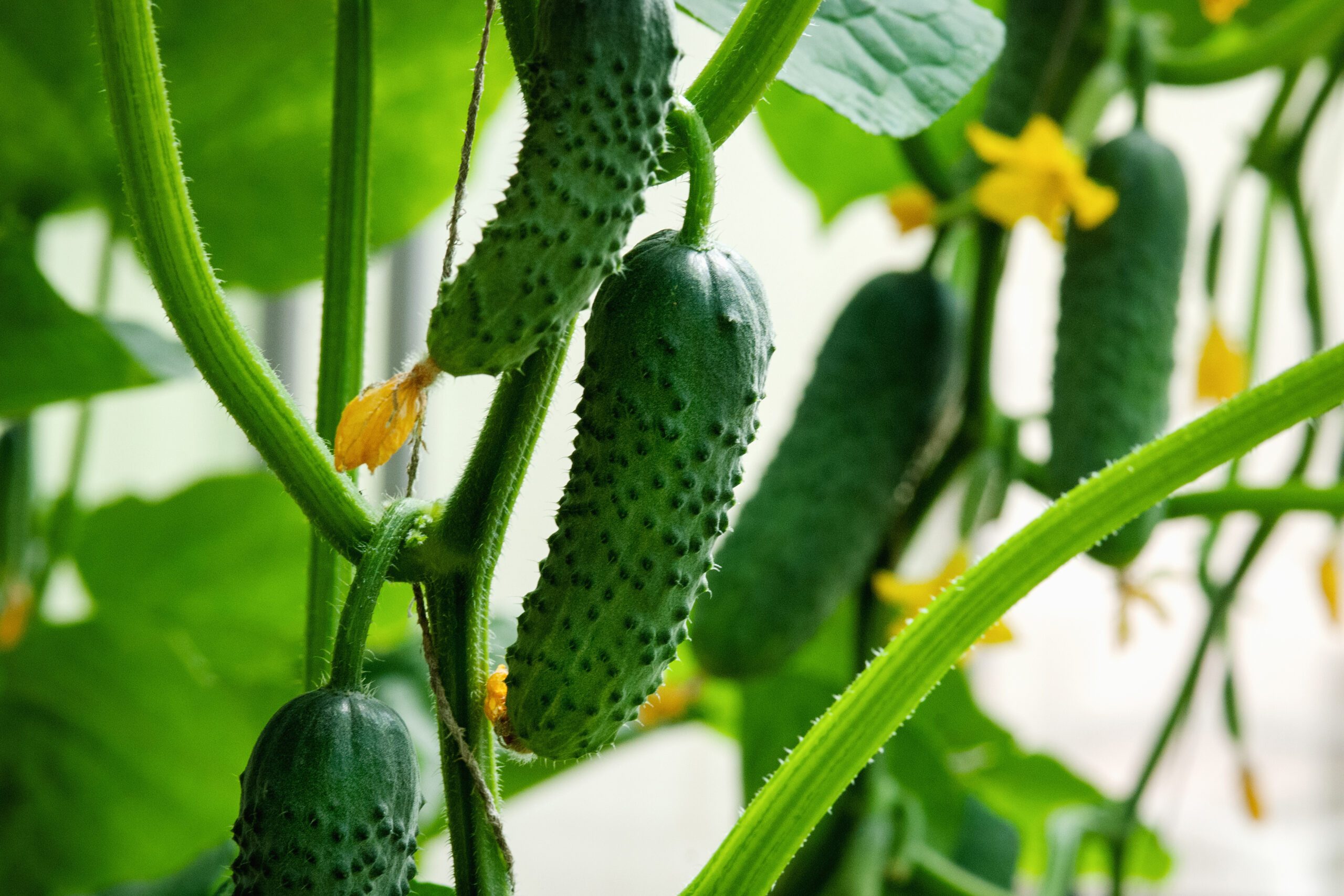Homegrown cucumbers are much tastier than store-bought, and they're easy to grow. Want to learn more? Read our cucumber growing guide.

How to Grow Cucumbers in Your Vegetable Garden

Many people would be surprised to discover a homegrown cucumber isn’t like the cucumbers sold in the grocery store. A homegrown garden cucumber will beat a store-bought veggie for taste every time. Plus, homegrown cucumbers are less watery and aren’t coated with the wax that is applied to protect store-bought varieties for shipping. Makes you want to learn how to grow your own cucumbers, doesn’t it? Here’s what you need to know!
Check out the ultimate guide to growing zucchini.
On This Page
Types of Cucumbers to Grow

When growing your own, you’ll find many more varieties than in the grocery store. Your available garden space determines how many types you can plant.
Slicing Cucumbers
These look like the typical cucumbers found in most grocery stores, but taste better. A popular variety is ‘Straight Eight.‘
Pickling Cucumbers
As the name implies, pickling cucumbers are smaller with thicker skins, making them great for making pickles. ‘National Pickling‘ is one of the many varieties.
English or Japanese Cucumbers
Several varieties produce longer fruit with thinner skins. Some are even seedless. In the grocery store, they’re usually wrapped in plastic to protect their thin skins, but you won’t need to do that when you grow your own. One such variety is ‘Tasty Green.’
Lemon Cucumbers
If you enjoy growing unique varieties of vegetables, try Lemon cucumbers, which produce round, yellow fruit.
Bush Cucumber Varieties
Some cucumbers have short vines and are labeled as bush cucumbers. They won’t need a trellis for support. But once the ground has warmed, you may want to put down straw mulch to protect the ripening cucumbers from rotting on the ground.
Psst—these mini vegetables are adorable AND edible.
How to Plant Cucumbers

Once you’ve chosen your cucumber seeds or plants, it’s time to get growing.
- Wait until about two weeks after the the last frost date in spring before direct sowing seeds or transplanting cucumber plants in the garden. Cucumbers love the heat, full sun and well-draining soil.
- If growing cucumber vines up a trellis, sow seeds approximately 1 foot apart. A simple A-frame trellis provides support for cucumbers and keeps them up off the ground.
- For bush-type cucumbers, sow several seeds in small hills, creating a mound of soil. Space the hills about 3 feet apart. Once seeds germinate, thin out seedlings to leave the two strongest plants.
Cucumber Care and Growing Tips

These vegetables are generally easy to grow. However, caring for cucumbers might involve getting rid of some pests and assisting with pollination.
Water
As with most garden vegetables, apply the equivalent of an inch of rainwater a week. If it rains regularly, you can skip the watering.
If your cucumber vines look wilted late in the day, check to see if the soil is dry before watering. Cucumber plants transpire a lot of water during the day, which causes them to wilt in the evening, but they’ll often perk back up by morning. If they don’t, it’s definitely time to water them. Water cucumber plants at the roots and avoid overhead sprinkling on the leaves.
Fertilizer
Cucumbers generally grow well in good garden soil amended with compost. Additional fertilizer may not be needed. If you decide to fertilize the plants, choose a fertilizer labeled for use in vegetable gardens and closely follow the directions on the package.
Insects and Diseases

Lots of insects love cucumbers, including aphids and striped cucumber beetles. Occasionally slugs can be problematic, along with plant diseases such as powdery mildew, which shows up as a white film on the leaves.
The best defense against all of these pest problems is to grow strong, healthy plants. But if you have a serious infestation, choose the safest option first, which may include hand-picking the insects and/or their eggs. Since you likely plan to eat the cucumbers, it’s wise to avoid insecticides and pesticides. These also harm the helpful pollinators that you are trying to attract.
Other good practices are to move your cucumber plants around each year so they aren’t always growing in the same spot, where those pests might be overwintering and waiting to strike again. Also, promptly remove plants once they’ve stopped producing cucumbers. If you see signs of disease, don’t compost the plants — send them out with the trash.
Here’s how to keep squash bugs out of your garden.
Pollinators

With rare exceptions like Kitchen Minis Quick Snack, which can be grown indoors, cucumbers need pollinators. Like most members of the squash family, cucumbers have separate male and female flowers. They need bees to get the pollen from the male flowers to the female flowers. If you’re not getting any cucumbers but you see blooms on the plants, or the cucumbers are small and misshapen, it may be because the flowers weren’t pollinated.
Encourage bees and other pollinators in your garden by planting flowers nearby that attract them, like zinnias or sunflowers. Occasionally you may have to hand pollinate your cucumber flowers if bees aren’t around to do it.
Harvesting Cucumbers

Now, the fun part!
- Pick cucumbers early in the morning to ensure the highest moisture content.
- Cut the cucumber off the vine instead of pulling it away.
- Wipe cucumbers off carefully to remove spiny growths on the skins.
- Harvest regularly to encourage plants to continue to bloom and produce more cucumbers.
How big your cucumbers should be before picking depends on the type. Small pickling-type cucumbers may be ready to harvest when just a few inches long. Other varieties may be 6 to 8 inches long. And Lemon cucumbers can be harvested when they’re about the size of a baseball.
Next, learn how to grow potatoes in a vegetable garden.



















